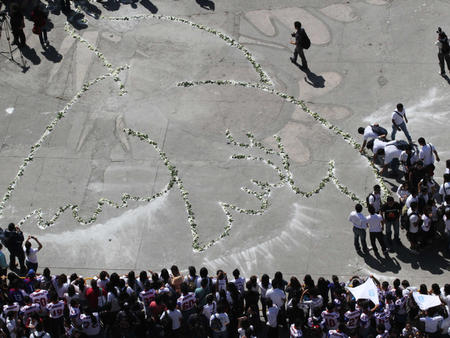 I blogged last week about the Obama administration’s attempt to control drug-war damage by regulating the flow of arms southward across the U.S.-Mexican border. This week we will look at a contradiction: The President’s people seek to control the damage, but at the same time they want to up the ante. You can’t go both ways at the same time.
I blogged last week about the Obama administration’s attempt to control drug-war damage by regulating the flow of arms southward across the U.S.-Mexican border. This week we will look at a contradiction: The President’s people seek to control the damage, but at the same time they want to up the ante. You can’t go both ways at the same time.
The New York Times’s Ginger Thompson reported last week that Washington is sending new CIA operatives and retired military personnel to Mexico and is considering the use of private security contractors to intensify the militarization of Mexico’s drug war. She reported that the CIA and the U.S. Drug Enforcement Agency (DEA) were coordinating Mexico’s ongoing drug war to a greater degree than ever before.
Mexican analysts have lost no time in pointing out that one of the consequences of this military intensification, and the direct role played by the Pentagon, is to bring the country’s anti-drug campaign more under U.S. control. We might also add that militarization—deploying soldiers to do police work—is not universally appreciated in Mexico, where it is frequently blamed for the rising drug war death toll, and is widely suspected of having social-control motives above and beyond the drug war itself (more on this in a future blog). Needless to say, U.S. control over a major military operation is even less appreciated, at least outside President Felipe Calderón’s circle of supporters and advisers.
The Times reports that the United States has trained nearly 4,500 Mexican federal police agents and has assisted and trained personnel in wiretapping, making effective use of informants and interrogating suspects. The Pentagon has provided the Mexican army with Black Hawk helicopters, and in recent months it has begun flying unarmed surveillance drones over Mexican soil to track known drug lords—Bin Laden style.
Upping the worry level is the fact that much of the training and supervision has been under the guidance of the U.S. Army’s Asymmetric Warfare Group (AWG). The AWG is a group formed to fight “asymmetric” military threats to the United States. That means that, at least to a certain degree, the Obama and Calderón administrations consider Mexico to be a war zone—not simply a site of a struggle against organized (and let us add brutal) criminals. The war is “asymmetric” because it is between belligerents of very different military strength.
It is worth taking a quick look at what high-ranking U.S. officers think of their mission in asymmetrical wars. Here are some excerpts from a short essay by retired Brigadier General David L. Grange:
Strategists define asymmetric warfare as conflict deviating from the norm, or an indirect approach to affect a counter-balancing of force. Such warfare is not new. Combatants throughout the ages have continually sought to negate or avoid the strength of the other, while applying one’s own strength against another’s weakness.
At the present time the U.S. has no identified conventional, war-making peer.... This absence of global peer competitors makes the world more uncertain, unstable, and difficult to anticipate.
…Today we see an ambiguous world, with people, groups, and governments pursuing complex goals. The borders have blurred between governments and people, military and populace, public and private. New fourth-generation warriors, non-national and trans-national groups based on ideology, religion, tribe, culture, zealotry, and illegal economic activities, have pushed many regions of the world into anarchy.
…The counter-drug war in Colombia and Mexico has intensified. Israel, the Middle East, North Korea, and Taiwan remain powder kegs. This dangerous environment, coupled with the increased use of our military as an extension of U.S. diplomacy, has placed us in a situation where our adversaries employ asymmetric tactics to negate superior conventional strength.
Note that this asymmetric warrior refers to Mexico, the Middle East, and North Korea all in the same breath. The problem in Mexico is that the military intensification of the “war” against the narcos and organized crime seems to have created the “adversaries” that the AWG needs, and has led some of those adversaries to “employ asymmetric tactics to negate superior conventional strength.” The death toll that is directly attributable to the war against organized crime stands at over 40,000 since Felipe Calderón took office in December 2006. Mexico is suffering as much from the effects of an ill-planned, U.S.-sponsored war as it is from the vicious depredations of the criminals themselves.
See Also:
Mexico Drug Crisis (NACLA Issue), 44.3, May/June, 2011
A Successful Failure, Joseph Nevins, August 10, 2011
Stemming the Arms Flow: Will Obama Face Down the NRA?, by Fred Rosen, August 9, 2011
Border Build-up Drones On, Joseph Nevins, May 18, 2011
Did you find this useful? Donate to NACLA

